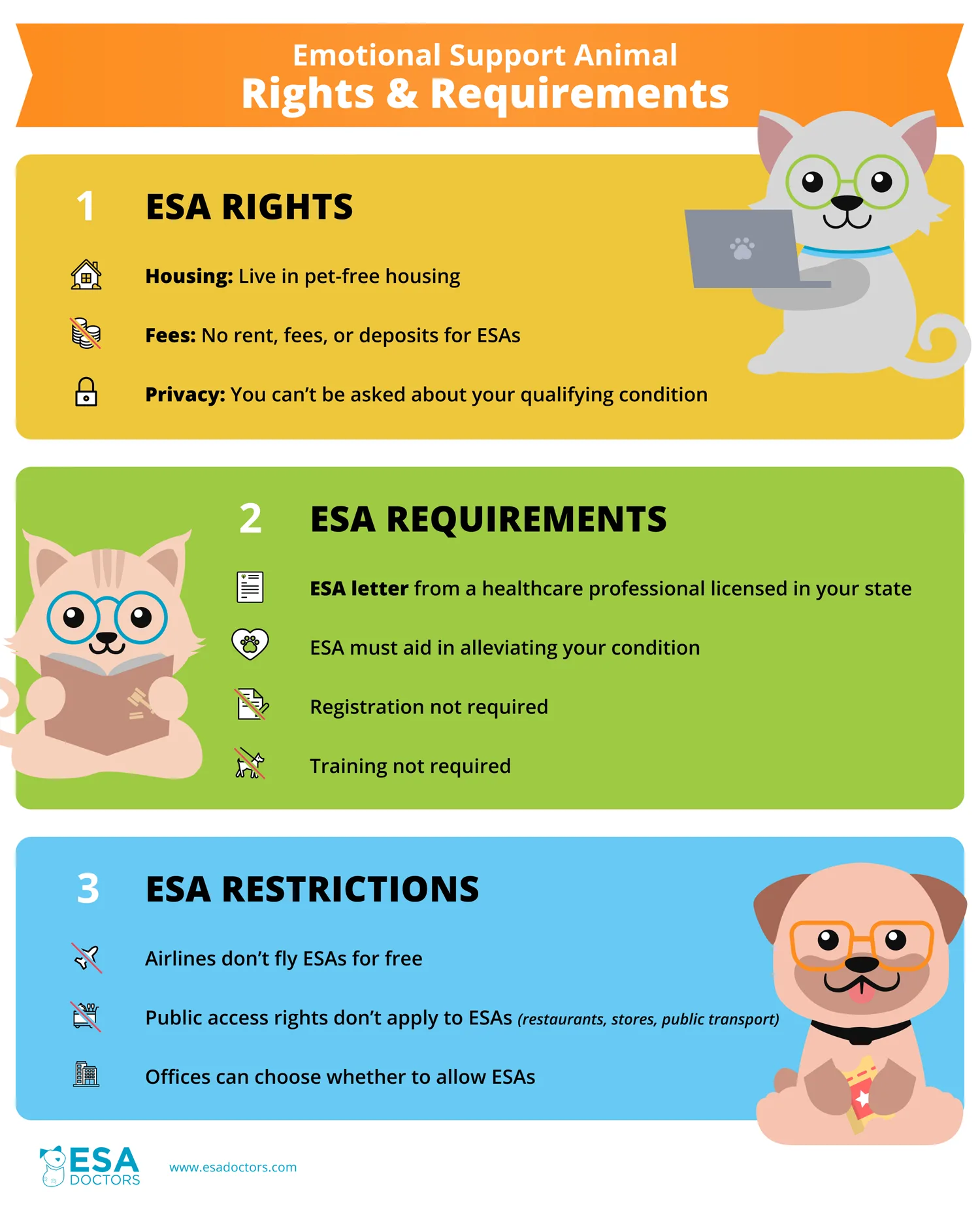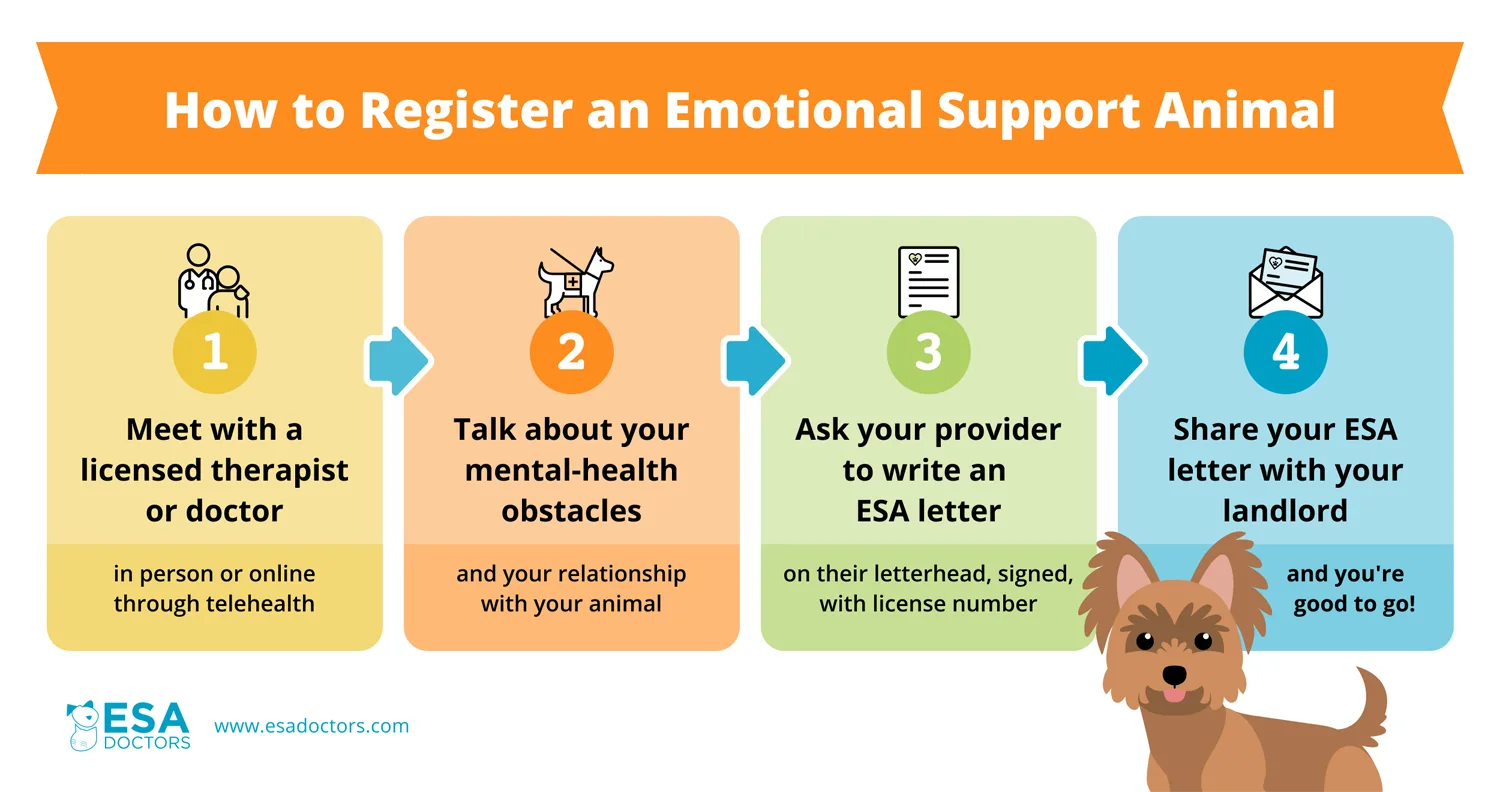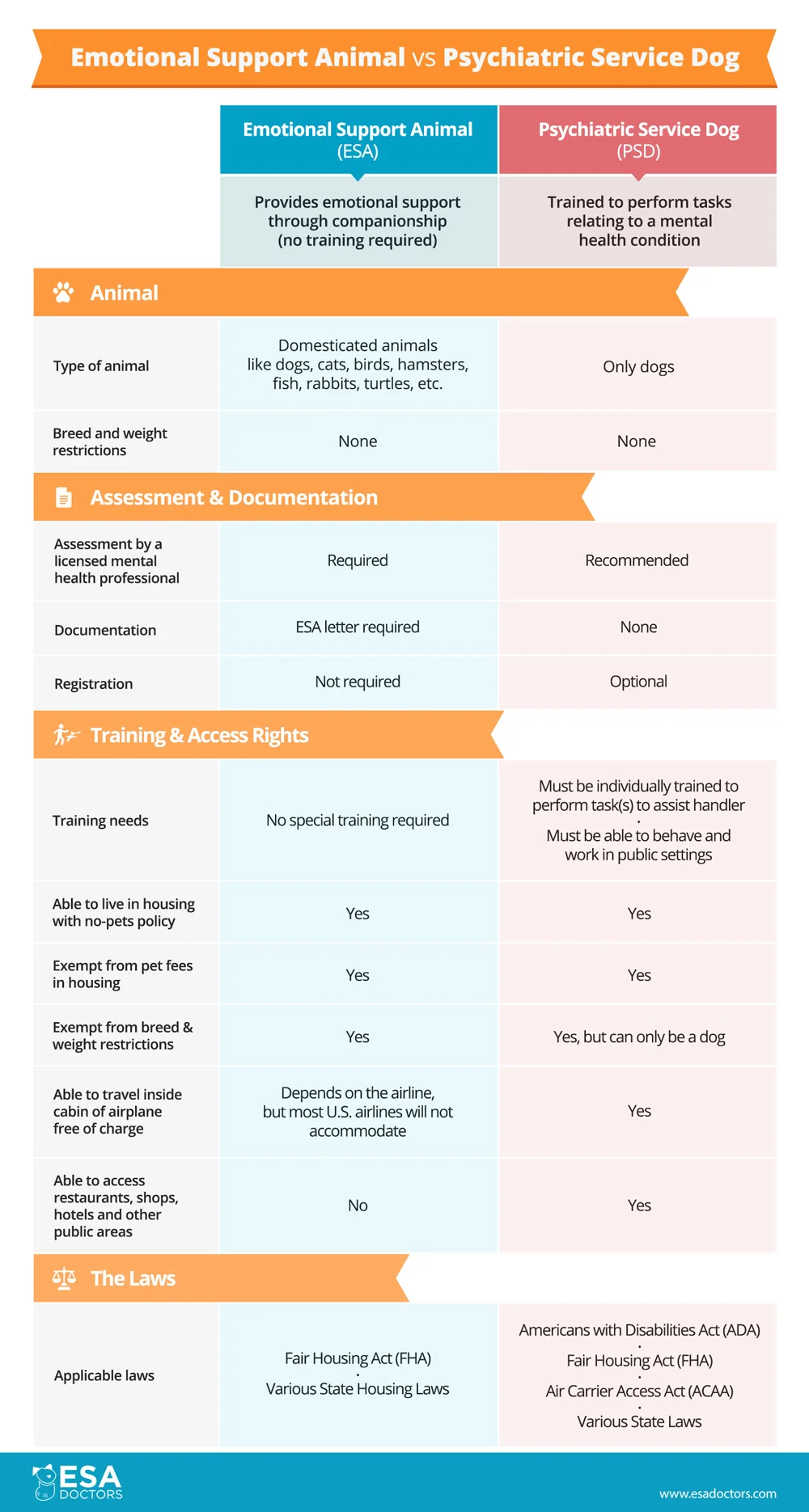Emotional support animals (ESA) are pets that provide comfort to owners with mental health disorders, including anxiety, depression, ADHD, OCD, and other disorders diagnosed by a licensed mental health professional.
Almost any household pet can be an emotional support animal, including dogs, cats, birds, fish, hamsters, and amphibians. An ESA doesn’t need any special trained abilities; it just has to make you feel better mentally and emotionally.
If you want to officially call your pet an emotional support animal, you have to get an ESA letter from a licensed medical professional, which gives you legal rights for housing, as long as your pet is well-behaved and doesn’t do anything dangerous, like attack a neighbor.
The Legal Rights of Emotional Support Animals and Their Owners
Having an emotional support animal gives you housing rights under the federal Fair Housing Act. ESA laws give you the following perks:
- Protection against landlord discrimination
- Exemption from no-pet policies
- Exemption from breed, weight, and size restrictions
- Waiver of all pet deposits and pet fees
To ensure these rights, you’ll need an ESA letter from a therapist or doctor licensed in your state. If you later move to another state, you’ll need to update your letter with a provider licensed for your new state.

Be aware that some states have slightly different requirements. For example, if you live in California, you must see the therapist for at least 30 days before getting an ESA letter. If you’re not sure about your state’s requirements, we have created a resource where you can learn more about ESA laws for your state. Our ESA experts and legal advisors constantly monitor and track the latest developments in ESA rules.
What Pets Can Be an Emotional Support Animal
According to HUD, an ESA can be any pet typically kept in the home. Some examples are dogs, cats, birds, fish, turtles, and hamsters. If you have a pet right now that you keep in your home, it can very likely become your emotional support animal!
Animals you’re not allowed to have as ESA are outdoor animals (like horses and cows) and “exotic” pets like snakes and hawks. You also can’t have ESAs that would create a safety or health issue for other tenants. For example, if you live in a small studio apartment, having 5 large and active German Shepherds is probably not a good idea.
Someone else’s mild allergies cannot prevent you from having an ESA. Landlords cannot reject your ESA from housing unless they pose “a direct threat to the health or safety” of others, and mild allergies would not meet that criteria. The DOJ has also stated that in relation to service dogs, allergies are not a reason for being able to deny an assistance animal.
For example, if your neighbor complains about a dog allergy, your housing provider must take steps to ensure all the tenants in the building are accommodated. That could mean more frequent cleanings of the common areas or better ventilation.

Ways to Prove Your Pet is an Emotional Support Animal
If you’re wondering how to get an emotional support animal or how you can legally call your existing pet an ESA, all you need is an up-to-date ESA letter that is signed by a licensed mental health professional. You can get an ESA letter if a licensed therapist or doctor believes your depression, anxiety, learning disorder, or other condition is severe enough and your animal makes you feel better.
For example, if you just had a tough exam season at school and are temporarily anxious, that’s probably not enough to qualify for an ESA letter. But, if you’re frequently depressed or anxious, and it gets in the way of your ability to work or study, that could be a great reason to get an ESA.
There’s no need for emotional support animal registration or an ESA certification. A signed ESA letter from a state-licensed mental health professional is all you need to prove that you have a real emotional support animal. If your landlord questions your ESA, all you need to do is show them a copy of your letter – they can’t ask for anything else.

Emotional Support Animals versus Service Dogs
Most service dogs also serve as emotional support animals, but most ESAs are not service animals, as service animals can only be dogs with specialized training. Service dogs, for example, may detect blood sugar running low or help guide a person with a mobility impairment, while an emotional support animal just does its job by being around to make you feel better.
There are many legal differences between a service animal vs emotional support animal. The main one is that service dogs are covered by the ADA, which gives them access rights to places like restaurants, stores, hotels, and airplanes, whereas ESAs mainly have housing rights.
One type of service dog, a psychiatric service dog (PSD), is similar to an emotional support animal in that it helps with mental health issues but has training to perform a job. For example, a PSD during a panic attack can be trained to actively respond to the handler by bringing medication or providing a comforting paw.

It takes more training and effort to qualify for a service dog. If your pet is helping just by being its friendly, furry self, and you don’t need it to perform any special tasks, an ESA is probably right for you.
The documentation process for ESAs and service dogs is also different. You need an ESA letter for an emotional support animal, while you don’t need a letter for a service dog. However, you can consider a PSD letter if your goal is to have a psychiatric service dog.
The Mental Health Benefits of Emotional Support Animals
Emotional support animals have been proven to have mental health benefits for you by altering your mental and emotional states. According to one study, interactions with dogs increased brain waves associated with stress relief and better focus, which is ideal for helping you during difficult times at work, school, or periods of depression. ESAs are known to calm your anxiety, with another study demonstrating that children who were around dogs and cats were less likely to develop anxiety.
While you don’t need any specialized training for your ESA, basic training can have health benefits for both you and your ESA, as this study showed that training a dog with positive reinforcement led to a more secure attachment style for the dog and more playfulness. You want to reduce any behavioral issues that could stress you out, as one study showed that the mental health of owners suffered when their dogs exhibited undesirable behaviors.
If your ESA is the type of pet that just likes to lay around and not learn new tricks, that’s okay, too! As long as the ESA isn’t doing anything to harm your neighbors, an ESA that makes you feel better just by looking at it is perfectly valid. If you don’t have the ability or desire to have a dog or cat, consider a more passive emotional support animal like a fish or turtle in an aquarium.
Where ESAs Can Go
Emotional support animals have the right to live in your home, even if your building or lease has a no-pets provision, but there are some misunderstandings about where emotional support animals can go.
ESAs can’t enter stores, restaurants, and other public venues that ban pets. Many progressive businesses, however, will allow you to bring your ESA in if you just ask, even though they aren’t obligated to do so legally. Unfortunately, ESAs can’t board airplanes free of charge (although they can if they meet the airline’s standard pet policy).
If you live in a no-pets building, you have the right to access common areas with your ESA as well as your apartment or unit. This means you can use the lobby, elevators, stairways, gardens, and pool areas.
How Many Emotional Support Animals You Can Have
You are not limited to just having one emotional support animal since you might have separate ESAs for different needs, like having an enthusiastic emotional support dog that alleviates depressive moods and an emotional support cat that keeps anxiety at bay.
If your therapist or doctor agrees that having more than one ESA can help you, they can recommend all of them in your ESA letter. If you have an ESA and adopt another one later, you’ll need the person who wrote your ESA letter to add them to your letter.
While there’s no technical limit to how many emotional support animals you can have, you must have an actual mental or emotional health need for each one. And, you have to be able to comfortably and safely accommodate them in your living space. They can’t create a nuisance or health hazard for your neighbors.

Get an Emotional Support Animal Online
If being able to call your pet your official emotional support animal or adopting an ESA would change your life, don’t hesitate to apply for an ESA letter.
Here at ESA Doctors, we work with compassionate and licensed mental health professionals who know the ins and outs of the ESA process. They can help you get an ESA letter quickly and easily while being compliant with your state’s unique ESA requirements.





Leave a Comment